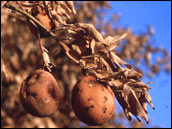

| |||
While much of the weather that we experience is brief and short-lived, drought is a more gradual phenomenon, slowly taking hold of an area and tightening its grip with time. In severe cases, drought can last for many years, and can have devastating effects on agriculture and water supplies. Nationwide losses from the U.S. drought of 1988 exceeded $40 billion, exceeding the losses caused by Hurricane Andrew in 1992, the Mississippi River floods of 1993, and the San Francisco earthquake in 1989. In some areas of the world, the effects of drought can be far more severe. In the Horn of Africa the 1984–1985 drought led to a famine which killed 750,000 people.
In general, drought is defined as an extended period–a season, a year, or several years–of deficient rainfall relative to the statistical multi-year average for a region. However, dozens of more specific drought definitions are used around the world that are defined according to the lack of rain over various time periods, or measured impacts such as reservoir levels or crop losses. Because of the various ways drought is measured, an objective drought definition has yet to be produced upon which everyone can agree. Drought can be defined according to meteorological, hydrological, or agricultural criteria.
|
by Steve Graham  Drought: the Creeping Disaster
Related Links:
| ||
For the purposes of this Web site, our definition most closely resembles that of an agricultural drought. The regions displayed as "in drought" on the maps on this site show areas of reduced plant growth, relative to the historical average, caused by reduced precipitation. The underlying cause of most droughts can be related to variations in large-scale atmospheric circulation patterns and the locations of anticyclones, or high-pressure systems. Sometimes, whirling masses of air separate from the main westerly airflow (analogous to whirlpools that form in rapidly flowing rivers) and effectively prevent the usual west-to-east progression of weather systems. When these "blocking systems" persist for extended periods of time, weather extremes such as drought, floods, heat waves, and cold snaps can occur. In addition, analyses of climate records and experiments with climate models have led climatologists to believe that many of the droughts in tropical regions are associated with global patterns of sea surface temperature anomalies (differences from normal) such as El Niño. During an El Niño, the anomalously warm equatorial Pacific Ocean warms the overlying atmosphere, which leads to changes in large-scale atmospheric circulation patterns, and increased probabilities of drought in many parts of the world. |
 One type of drought occurs when natural vegetation and agricultural crops don't receive enough water. (Photograph courtesy U.S. Department of Agriculture) | ||